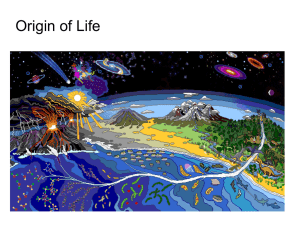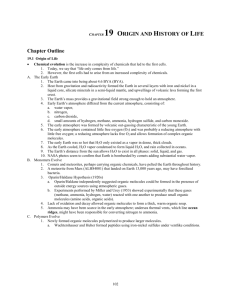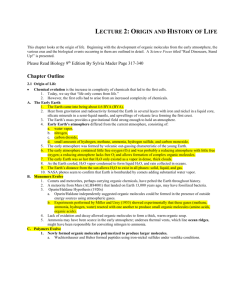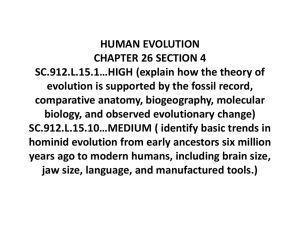U5L1EarthLifeOrigins
advertisement
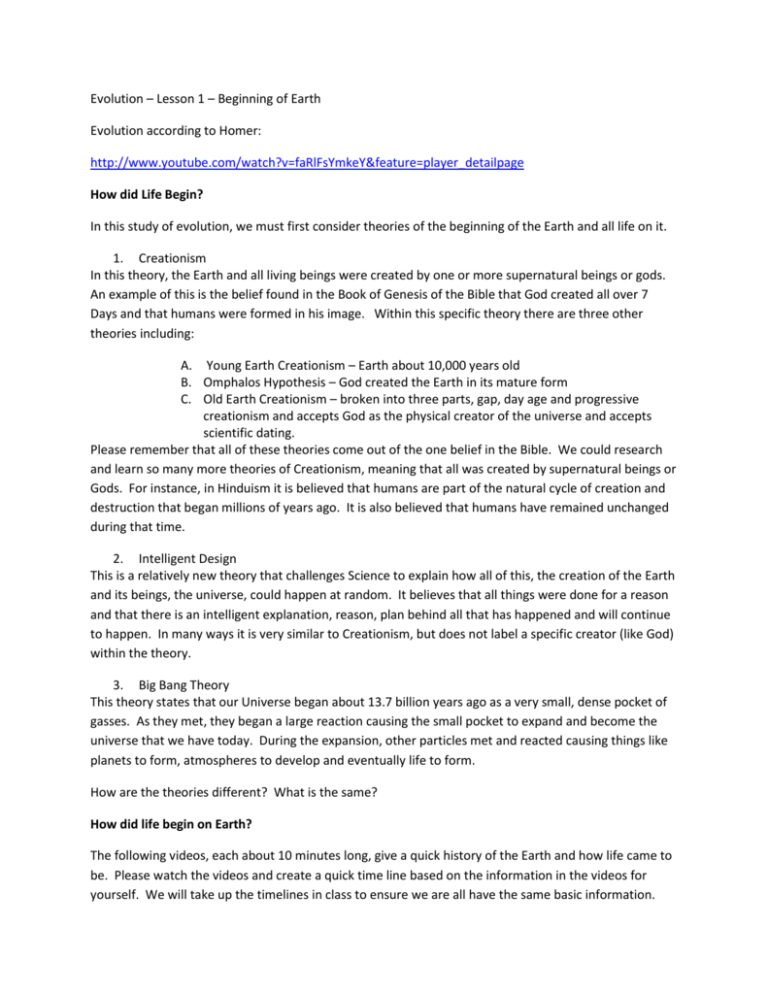
Evolution – Lesson 1 – Beginning of Earth Evolution according to Homer: http://www.youtube.com/watch?v=faRlFsYmkeY&feature=player_detailpage How did Life Begin? In this study of evolution, we must first consider theories of the beginning of the Earth and all life on it. 1. Creationism In this theory, the Earth and all living beings were created by one or more supernatural beings or gods. An example of this is the belief found in the Book of Genesis of the Bible that God created all over 7 Days and that humans were formed in his image. Within this specific theory there are three other theories including: A. Young Earth Creationism – Earth about 10,000 years old B. Omphalos Hypothesis – God created the Earth in its mature form C. Old Earth Creationism – broken into three parts, gap, day age and progressive creationism and accepts God as the physical creator of the universe and accepts scientific dating. Please remember that all of these theories come out of the one belief in the Bible. We could research and learn so many more theories of Creationism, meaning that all was created by supernatural beings or Gods. For instance, in Hinduism it is believed that humans are part of the natural cycle of creation and destruction that began millions of years ago. It is also believed that humans have remained unchanged during that time. 2. Intelligent Design This is a relatively new theory that challenges Science to explain how all of this, the creation of the Earth and its beings, the universe, could happen at random. It believes that all things were done for a reason and that there is an intelligent explanation, reason, plan behind all that has happened and will continue to happen. In many ways it is very similar to Creationism, but does not label a specific creator (like God) within the theory. 3. Big Bang Theory This theory states that our Universe began about 13.7 billion years ago as a very small, dense pocket of gasses. As they met, they began a large reaction causing the small pocket to expand and become the universe that we have today. During the expansion, other particles met and reacted causing things like planets to form, atmospheres to develop and eventually life to form. How are the theories different? What is the same? How did life begin on Earth? The following videos, each about 10 minutes long, give a quick history of the Earth and how life came to be. Please watch the videos and create a quick time line based on the information in the videos for yourself. We will take up the timelines in class to ensure we are all have the same basic information. Please do not worry about the last minute of the The First Humans video, we will discuss this topic later in much more detail. YouTube Origin Evolution of Life http://www.youtube.com/watch?v=8SgnnV8nV9g&feature=player_detailpage The First Humans http://www.youtube.com/watch?feature=player_detailpage&v=s-nLJI2BZIM The following notes are taken from a textbook and are in point form found at: http://www.biologycorner.com/APbiology/evolution/ch19.html . These notes offer explanations to some of the info found in the videos. We will take a quick look and then start the next section on History of Life. Chemical evolution is the increase in complexity of chemicals that led to the first cells. 1. Today, we say that "life only comes from life." 2. However, the first cells had to arise from an increased complexity of chemicals. A. The Early Earth 1. The Earth came into being about 4.6 BYA (BYA). 2. Heat from gravitation and radioactivity formed the Earth in several layers with iron and nickel in a liquid core, silicate minerals in a semi-liquid mantle, and upwellings of volcanic lava forming the first crust. 3. The Earth's mass provides a gravitational field strong enough to hold an atmosphere. 4. Early Earth's atmosphere differed from the current atmosphere, consisting of: a. water vapor, b. nitrogen, c. carbon dioxide, d. small amounts of hydrogen, methane, ammonia, hydrogen sulfide, and carbon monoxide. 5. The early atmosphere was formed by volcanic out-gassing characteristic of the young Earth. 6. The early atmosphere contained little free oxygen (O2) and was probably a reducing atmosphere with little free oxygen; a reducing atmosphere lacks free O2 and allows formation of complex organic molecules. 7. The early Earth was so hot that H2O only existed as a vapor in dense, thick clouds. 8. As the Earth cooled, H2O vapor condensed to form liquid H2O, and rain collected in oceans. 9. The Earth's distance from the sun allows H2O to exist in all phases: solid, liquid, and gas. 10. NASA photos seem to confirm that Earth is bombarded by comets adding substantial water vapor. B. Monomers Evolve 1. Comets and meteorites, perhaps carrying organic chemicals, have pelted the Earth throughout history. 2. A meteorite from Mars (ALH84001) that landed on Earth 13,000 years ago, may have fossilized bacteria. 3. Oparin/Haldane Hypothesis (1920s) a. Oparin/Haldane independently suggested organic molecules could be formed in the presence of outside energy sources using atmospheric gases. b. Experiments performed by Miller and Urey (1953) showed experimentally that these gases (methane, ammonia, hydrogen, water) reacted with one another to produce small organic molecules (amino acids, organic acids). 4. Lack of oxidation and decay allowed organic molecules to form a thick, warm organic soup. 5. Ammonia may have been scarce in the early atmosphere; undersea thermal vents, which line ocean ridges, might have been responsible for converting nitrogen to ammonia. C. Polymers Evolve 1. Newly formed organic molecules polymerized to produce larger molecules. a. Wachtershauser and Huber formed peptides using iron-nickel sulfides under ventlike conditions. b. Such minerals have a charged surface that attracts amino acids and provides electrons so they bond together. 2. Protein-first Hypothesis a. Sidney Fox demonstrated amino acids polymerize abiotically if exposed to dry heat. b. Amino acids collected in shallow puddles along the rocky shore; heat of the sun caused them to form proteinoids (i.e., small polypeptides that have some catalytic properties). c. When proteinoids are returned to water, they form cell-like microspheres composed of protein. d. This assumes DNA genes came after protein enzymes; DNA replication needs protein enzymes. 3. The Clay Hypothesis a. Graham Cairns-Smith suggests that amino acids polymerize in clay, with radioactivity providing energy. b. Clay attracts small organic molecules and contains iron and zinc atoms serving as inorganic catalysts for polypeptide formation. c. Clay collects energy from radioactive decay and discharges it if temperature or humidity changes. d. If RNA nucleotides and amino acids became associated so polypeptides were ordered by and helped synthesize RNA, then polypeptides and RNA arose at the same time. 4. RNA-first Hypothesis a. Only the macromolecule RNA was needed at the beginning to lead to the first cell. b. Thomas Cech and Sidney Altman discovered that RNA can be both a substrate and an enzyme. c. RNA would carry out processes of life associated with DNA (in genes) and protein enzymes. d. Supporters of this hypothesis label this an "RNA world" 4 BYA. D. A Protocell Evolves 1. Before the first true cell arose, there would have been a protocell or protobiont. 2. A protocell would have a lipid-protein membrane and carry on energy metabolism. 3. Fox showed that if lipids are made available to microspheres, lipids become associated with microspheres producing a lipid-protein membrane. 4. Oparin demonstrated a protocell could have developed from coacervate droplets. a. Coacervate droplets are complex spherical units that spontaneously form when concentrated mixtures of macromolecules are held in the right temperature, ionic composition, and pH. b. Coacervate droplets absorb and incorporate various substances from the surrounding solution. c. In a liquid environment, phospholipid molecules spontaneously form liposomes, spheres surrounded by a layer of phospholipids; this is called the "membrane-first" hypothesis. d. A protocell could have contained only RNA to function as both genetic material and enzymes. 5. If a protocell was a heterotrophic fermenter living on the organic molecules in the organic soup that was its environment, this would indicate heterotrophs preceded autotrophs. a. A heterotroph is an organism that cannot synthesize organic compounds from inorganic substances and therefore must take in preformed organic compounds. b. An autotroph is an organism that makes organic molecules from inorganic nutrients. 6. If the protocell evolved at hydrothermal vents, it would be chemosynthetic and autotrophs would have preceded heterotrophs. 7. The first protocells may have used preformed ATP, but as supplies dwindled, natural selection would favor cells that could extract energy from carbohydrates to transform ADP to ATP. 8. Since glycolysis is a common metabolic pathway in living things, it evolved early in the history of life. 9. As there was no free O2, it is assumed that protocells carried on a form of fermentation. 10. The first protocells had a limited ability to break down organic molecules; it took millions of years for glycolysis to evolve completely. 11. Fox has shown that a microsphere has some catalytic ability; Oparin found that coacervates incorporate enzymes if they are available in the medium. E. A Self-Replication System Evolves 1. In living systems, information flows from DNA ? RNA ? protein; it is possible that this sequence developed in stages. 2. The RNA-first hypothesis suggests that the first genes and enzymes were RNA molecules. a. These genes would have directed and carried out protein synthesis. b. Ribozymes are RNA that acts as enzymes. c. Some viruses contain RNA genes with a protein enzyme called reverse transcriptase that uses RNA as a template to form DNA; this could have given rise to the first DNA. 3. The protein-first hypothesis contends that proteins or at least polypeptides were the first to arise. a. Only after the protocell develops complex enzymes could it form nucleic acids from small molecules. b. Because a nucleic acid is complicated, the chance that it arose on its own is minimal. c. Therefore, enzymes are needed to guide the synthesis of nucleotides and then nucleic acids. 4. Cairns-Smith suggests that polypeptides and RNA evolved simultaneously. a. The first true cell would contain RNA genes that replicated because of the presence of proteins; they become associated in clay in such a way that the polypeptides catalyzed RNA formation. b. This eliminates the chicken-and-egg paradox; both events happen at the same time. 5. Once the protocell was capable of reproduction, it became a true cell and biological evolution began. a. After DNA formed, the genetic code still had to evolve to store information. b. Because the current code is subject to fewer errors than other possible codes, and because it minimizes mutations, it likely underwent a natural selection process. 6. Most biologists suspect life evolved in basic steps. a. Abiotic synthesis of organic molecules such as amino acids occurred in the atmosphere or at hydrothermal vents. b. Monomers joined together to form polymers at seaside rocks or clay, or at vents; the first polymers could have been proteins or RNA or both. c. Polymers aggregated inside a plasma membrane to make a protocell that had limited ability to grow; if it developed in the ocean it was a heterotroph, if at a hydrothermal vent, a chemoautotroph. d. Once the protocell contained DNA genes or RNA molecules, it was a true cell. Geologists have devised the geological timescale, which divides the history of Earth into eras, and then periods and epochs. Era Precambrian Period Years Ago 4.5 billion Major Events First living cells Bacteria Photosynthesis Algae First invertebrates 590 million Algae Marine Invertebrates 505 million Arthropods Mollusks First fish Fungi Silurian 438 million Many fish Trilobites Vascular Plants Plants on Land Arthropods on Land Devonian "Age of Fishes" 408 million Lots o' fishes First amphibians and insects Carboniferous 360 million Mosses Many amphibians First reptiles 286 million Mass marine extinction Amphibian decline Pangaea Triassic 248 million First mammals Dinosaurs Pangaea begins to separate Jurassic 213 million Dinosaurs dominate First birds Cretaceous 144 million Flowering plants Mass extinction Tertiary 65 million Birds,mammals, insects flourish Continents in modern positions Quaternary 2 million to present First hominids Ice Ages Extinction of giant mammals Cambrian Ordovician Paleozoic Permian Mesozoic "Age of Reptiles" Cenozoic "Age of Mammals" (mammoth) History of Life A. Fossils Tell a Story 1. A fossil is the remains or traces of past life, usually preserved in sedimentary rock. 2. Most dead organisms are consumed by scavengers or decompose. 3. Paleontology is the study of fossils and the history of life, ancient climates, and environments. 4. Sedimentation has been going on since the Earth was formed; it is an accumulation of particles forming a stratum, a recognizable layer in a stratigraphic sequence laid down on land or in water. 5. The sequence indicates the age of fossils; a stratum is older than the one above it and younger than the one below it. B. Relative Dating of Fossils 1. Strata of the same age in England and Russia may have different sediments. 2. However, geologists discovered that strata of the same age contain the same fossils, termed index fossils. 3. Therefore, fossils can be used for the relative dating of strata. 4. A particular species of fossil ammonite is found over a wide range and for a limited time period; therefore, all strata in the world that contain this ammonite are of the same age. 5. However, relative dating does not establish the absolute age of fossils in years. C. Absolute Dating of Fossils 1. Absolute dating relies on radioactive dating to determine the actual age of fossils. 2. Radioactive isotopes have a half-life, the time it takes for half of a radioactive isotope to change into a stable element. 3. Carbon 14 (14C) is a radioactive isotope contained within organic matter. a. Half of the carbon 14 (14C) will change to nitrogen 14 (14N) every 5,730 years. b. Comparing 14C radioactivity of a fossil to modern organic matter calculates the age of the fossil. c. After 50,000 years, the 14C radioactivity is so low it cannot be used to measure age accurately. 4. It is possible to determine the ratio of potassium 40 (40K) and argon 40 to date rocks and infer the age of a fossil. What is Pangea? Continental Drift? Plate tectonics is the study of the lithosphere, the outer portion of the earth consisting of the crust and part of the upper mantle. The lithosphere is divided into about a dozen large plates which move and interact with one another to create earthquakes, mountain ranges, volcanic activity, ocean trenches and many other features. Continents and ocean basis are moved and changed in shape as a result of these plate movements. The sequence of maps show how a large supercontinent, known as Pangaea was fragmented into several pieces, each being part of a mobile plate of the lithosphere. These pieces were to become Earth's current continents. The time sequence show through the maps traces the paths of the continents to their current positions.. In the early 1900's Alfred Wegener proposed the idea of Continental Drift. His ideas centered around continents moving across the face of the earth. The idea was not quite correct - compared to the plate tectonics theory of today - but his thinking was on the proper track. In addition, a variant spelling of Pangaea is "Pangea". It appears in some textbooks and glossaries, however, Pangaea is the current preferred spelling.

